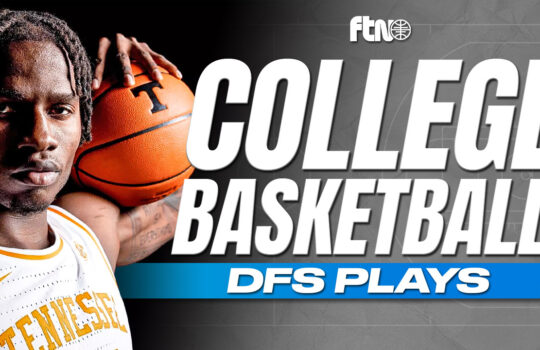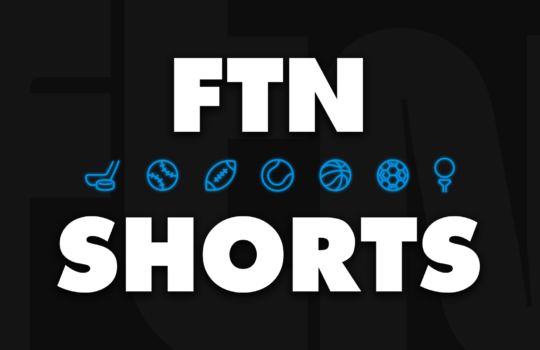
A year ago at this time, I attempted to name the five teams most likely to decline in overall fantasy performance in 2023. I went 3-for-5, hitting on the Jaguars, Giants and Eagles but missing on the Lions and Dolphins.
Pop quiz: What was the most important part of the preceding paragraph?
Answer: The phrase “at this time.”
That is the most important part of the paragraph because everything that follows in this space is agnostic to the moves the given teams make this coming offseason. The moves matter, changes in scheme matter, career progression matters, but what matters the most is simple regression.
Performance can swing 5% in a direction and keep that momentum going. But if it swings 20%? It’s going to swing back. Maybe not every single time, but often enough that you can bet on it happening every time and be right more often than you’re wrong.
Take the Indianapolis Colts. From 2013 to 2014 the Colts saw their fantasy scoring (PPR points, only QB-RB-WR-TE) rise 21.5%. Then it dropped 23.5% in 2015. It rose 18.5% in 2016, dropped 28.4% in 2017, rose 53.6% in 2018, fell 23.6% in 2019.
You get the idea. Big swings almost inevitably are followed up by dramatic swings back. From 2006 to 2021, 22 teams saw their year-over-year fantasy point total drop by at least 20%. Of those 22, 18 (81.8%) bounced back in the opposite direction the next year. On the other side, 60 teams climbed by at least 20% (ever-increasing scoring makes big jumps easier than big declines), and 44 (73.3%) fell the third year. Offseason machinations do matter, but you can’t outrun math.
Below, I’ll update the chart from last year to better illustrate this, featuring 512 team-seasons from 2006 to 2021 (to give us three-year chunks of data):
| Year 1-2 change | # of teams | Average change, Year 1-2 |
Average change, Year 2-3 |
| up 30% or more | 17 | +39.1% | -6.8% |
| up 20-30% | 43 | +24.2% | -6.5% |
| up 10-20% | 72 | +14.7% | -2.9% |
| up 0-10% | 137 | +4.8% | +0.8% |
| down 0-10% | 148 | -5.0% | +3.7% |
| down 10-20% | 68 | -13.8% | +6.9% |
| down 20-30% | 22 | -24.0% | +17.3% |
| down 30% or more | 5 | -34.7% | +25.3% |
So with that in mind, today we’re looking at the five teams most likely to decline in fantasy scoring in 2024. Not based on what they’ll do in free agency or the draft, not based on a coaching or scheme change. Just based on math. (Thursday, we looked at the teams most likely to improve.)

5 Teams Set to Decline in Fantasy in 2023
As mentioned at the top, the five teams in this space last year were, in order, the Jaguars, Lions, Giants, Eagles and Dolphins. That went 3-for-5 in all. Three of five isn’t that great a hit rate, but in the aggregate, they went from an increase of 16.3% from 2021 to 2022 to a drop of 1.9% from 2022 to 2023. If you listened to this piece last year, sure, maybe you missed out on Jahmyr Gibbs, Amon-Ra St. Brown, Raheem Mostert and Tyreek Hill, but you also faded guys like Trevor Lawrence, Darren Waller, Saquon Barkley and Jaylen Waddle, and that’s not so bad.
(Reminder: All fantasy scoring is PPR, and offensive players only.)
1. Los Angeles Rams (+25.5%)
2022 fantasy scoring: 1,205.0
2023 fantasy scoring: 1,513.5
What Went Right
Puka Nacua came in virtually undrafted (“virtually” because I loved the dude and drafted him in a few leagues, but now I’m just using this parenthetical to brag) and finished as the WR4. Kyren Williams was similarly ignored and ended as the RB7 despite missing a month. Matthew Stafford played almost the whole season after injuries killed his 2022. Cooper Kupp didn’t return as strong as many hoped, but it ended up not mattering that much.
Why They Might Fall Off
While there are no obvious reasons why Nacua or Williams might be flukes, it’s never a bad idea to be wary of out-of-nowhere seasons, because there’s a reason guys went overlooked in the first place. Add in age for Stafford (36) and Kupp (31 in June) and the fact that Tyler Higbee tore his ACL in the playoffs, and the team has very little room for error.
2. Houston Texans (+24.5%)
2022 fantasy scoring: 1,207.1
2023 fantasy scoring: 1,502.8

What Went Right
“It wasn’t 2022 anymore” about sums it up. The Texans had Davis Mills as its No. 1 quarterback in 2022, Dameon Pierce as the primary running back, and Brandin Cooks and Chris Moore as the leading target-getters. None of that was true in 2023, with Mills benched for No. 2 overall pick C.J. Stroud, Cooks and Moore gone, and Pierce rendered irrelevant by free agent surprise Devin Singletary. Add in a breakout year from Nico Collins, a dynamite (if truncated) rookie campaign for Tank Dell and even spurts of exciting performance from Noah Brown, and things clicked for the Texans in their first year under new coach DeMeco Ryans.
Why They Might Fall Off
Really, this one just comes down to “because math says so.” You’d expect Stroud to build on an Offensive Rookie of the Year campaign, with Collins and Dell both ideally healthy for a full season. The backfield needs to be worked out, with Pierce a disappointment and Singletary a free agent again, and Dalton Schultz heads into free agency as well, but in this instance it’s just, “The numbers say they’ll regress.”
3. Baltimore Ravens (+21.6%)
2022 fantasy scoring: 1,264.3
2023 fantasy scoring: 1,537.4
What Went Right
After missing five games each in 2021 and 2022, Lamar Jackson stayed healthy in 2023 and won the MVP. That’s really the whole thing, though it’s also worth noting that, while overall the revamped receiver corps wasn’t all it was cracked up to be (neither Rashod Bateman nor Odell Beckham really made their mark), Zay Flowers was a hit, and Isaiah Likely filled in for an injured Mark Andrews admirably.
Why They Might Fall Off
Since becoming the starter, the only two seasons of Lamar Jackson’s career that he hasn’t had to miss a game (last-week-of-the-season meaningless games excepted), he’s won the MVP. So obviously the main thing here is for him to be healthy. On top of that, J.K. Dobbins and Gus Edwards are both hitting free agency, and Keaton Mitchell tore his ACL late in the year, so the backfield is a huge question mark. And while Flowers was a fine rookie, the team needs more than one reliable receiver.
4. San Francisco 49ers (+16.7%)
2022 fantasy scoring: 1,432.0
2023 fantasy scoring: 1,671.7

What Went Right
The Trey Lance/Jimmy Garoppolo tenures in 2022 were actually fine. They just weren’t much more than that, and when Brock Purdy took over things hit a new level. Of course, Purdy took over right around the same time the 49ers traded for Christian McCaffrey, which obviously might be a bigger factor. Add in health — McCaffrey, Brandon Aiyuk and George Kittle missed a combined one game that mattered, and even Deebo Samuel missed only two — and everything that could have broken right for this offense did.
Why They Might Fall Off
Last year in this space, I said health was my biggest concern for the Jaguars, with their top five weapons missing a combined one game in 2022. Those five guys missed 14 combined games in 2023. That’s where it starts for the 49ers in 2024. For a team with a long history of guys getting banged up to be as healthy as it was last year was a long shot, and repeating it is even longer. On top of that, the offensive line was basically “Trent Williams and hope for the best,” and while Williams is still one of the game’s best tackles and might be able to keep doing that, he also turns 36 in July, so the end is at least somewhat in sight.
5. Chicago Bears (+12.3%)
2022 fantasy scoring: 1,140.2
2023 fantasy scoring: 1,280.5
What Went Right
OK, not just that, but he certainly was a big factor. No Bear topped 69 targets, 50 receptions or 544 receiving yards in 2022; Moore put up 132, 96 and 1,364, respectively, in 2023. Cole Kmet also put up career highs in all three numbers, and having Moore helped Fields go from 149.5 passing yards per game to 197.1.
Why They Might Fall Off
Here’s a real hard one, actually. Because if the Bears commit to Fields this offseason, it’s because they believe he has another step forward he can take. And if they move on from Fields, it will be for a top-of-the-draft rookie. Either way, you’d have to have some faith in the quarterback situation (and either will be better than four games of Tyson Bagent). The team has excellent draft stock and the third-most cap space, so Chicago should also be able to bolster its line and/or the receiving corps behind Moore.
The Bears only improved by 12.3% from 2022 to 2023, which is below our typical threshold for obvious regression. There just weren’t many huge gainers in 2023. So in the end, the answer to why the Bears might decline is “Actually, they might buck the trend.”

















































 New York Jets
New York Jets  New England Patriots
New England Patriots  Miami Dolphins
Miami Dolphins  Buffalo Bills
Buffalo Bills  Pittsburgh Steelers
Pittsburgh Steelers  Cleveland Browns
Cleveland Browns  Cincinnati Bengals
Cincinnati Bengals  Baltimore Ravens
Baltimore Ravens  Tennessee Titans
Tennessee Titans  Jacksonville Jaguars
Jacksonville Jaguars  Indianapolis Colts
Indianapolis Colts  Houston Texans
Houston Texans  Las Vegas Raiders
Las Vegas Raiders  Los Angeles Chargers
Los Angeles Chargers  Kansas City Chiefs
Kansas City Chiefs  Denver Broncos
Denver Broncos  Washington Commanders
Washington Commanders  Philadelphia Eagles
Philadelphia Eagles  New York Giants
New York Giants  Dallas Cowboys
Dallas Cowboys  Minnesota Vikings
Minnesota Vikings  Green Bay Packers
Green Bay Packers  Detroit Lions
Detroit Lions  Chicago Bears
Chicago Bears  Tampa Bay Buccaneers
Tampa Bay Buccaneers  New Orleans Saints
New Orleans Saints  Carolina Panthers
Carolina Panthers  Atlanta Falcons
Atlanta Falcons  San Francisco 49ers
San Francisco 49ers  Seattle Seahawks
Seattle Seahawks  Los Angeles Rams
Los Angeles Rams  Arizona Cardinals
Arizona Cardinals 





 Boston Celtics
Boston Celtics  Brooklyn Nets
Brooklyn Nets  Philadelphia 76ers
Philadelphia 76ers  New York Knicks
New York Knicks  Toronto Raptors
Toronto Raptors  Chicago Bulls
Chicago Bulls  Detroit Pistons
Detroit Pistons  Milwaukee Bucks
Milwaukee Bucks  Cleveland Cavaliers
Cleveland Cavaliers  Indiana Pacers
Indiana Pacers  Orlando Magic
Orlando Magic  Atlanta Hawks
Atlanta Hawks  Charlotte Hornets
Charlotte Hornets  Miami Heat
Miami Heat  Washington Wizards
Washington Wizards  Denver Nuggets
Denver Nuggets  Minnesota Timberwolves
Minnesota Timberwolves  Oklahoma City Thunder
Oklahoma City Thunder  Portland Trail Blazers
Portland Trail Blazers  Utah Jazz
Utah Jazz  LA Clippers
LA Clippers  Golden State Warriors
Golden State Warriors  Los Angeles Lakers
Los Angeles Lakers  Phoenix Suns
Phoenix Suns  Sacramento Kings
Sacramento Kings  Dallas Mavericks
Dallas Mavericks  Houston Rockets
Houston Rockets  Memphis Grizzlies
Memphis Grizzlies  New Orleans Pelicans
New Orleans Pelicans  San Antonio Spurs
San Antonio Spurs 











